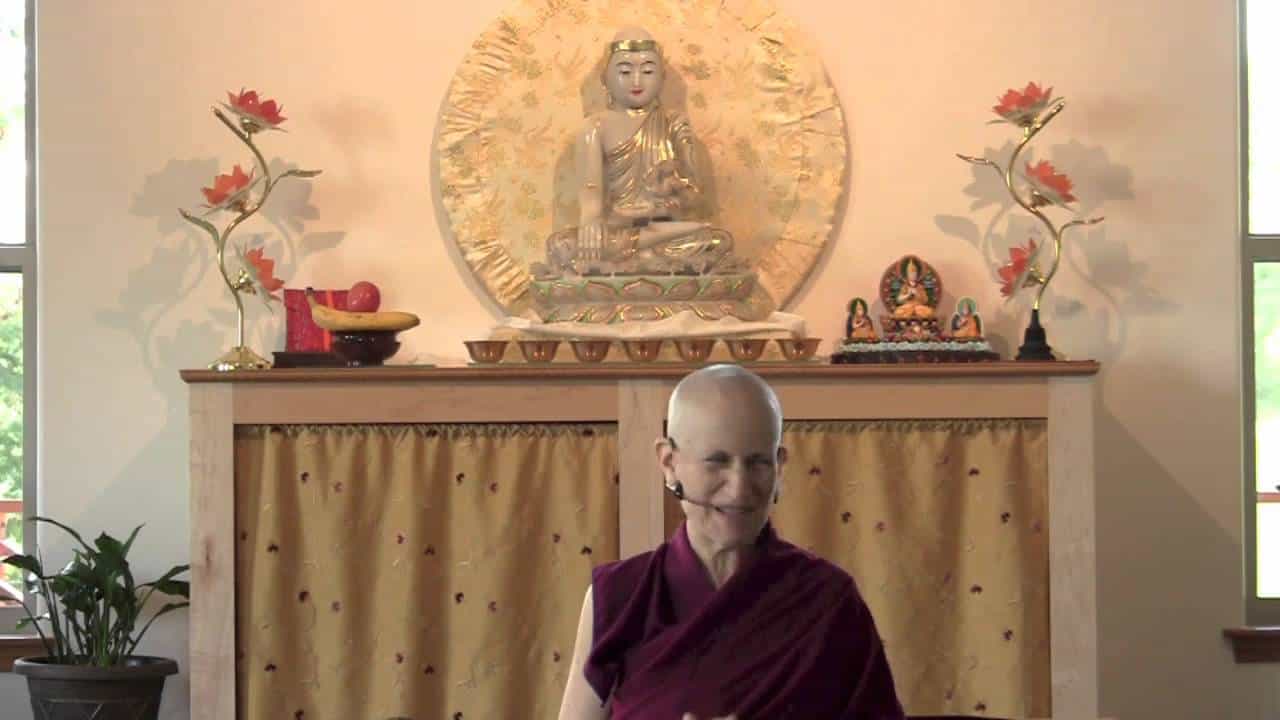Verse 102: The sparkling mirror
Part of a series of talks on Gems of Wisdom, a poem by the Seventh Dalai Lama.
- When the mind is focused it knows the object more easily
- Certain conditions for a serenity retreat
- The five hindrances to concentration
- Developing serenity a prerequisite to developing the super-knowledges
Gems of Wisdom: Verse 102 (download)
What is the sparkling mirror reflecting even invisible images?
The firm yoga of serenity not disturbed by laxity or excitement.
So you want to know the “sparkling mirror.”
Well, the mind is like a mirror, isn’t it? When the mind is focused, and there’s concentration, then it’s much easier for the mind to know an object and reflect that object in the way that a mirror reflects the object. When our mind is clouded with afflictions and distractions and opinions and everything else it can’t reflect anything except the garbage that we’re churning up in our own mind.
When our mind is more concentrated then it’s more peaceful (and) it can see things more clearly. For example, if you want to develop the wisdom realizing emptiness, having a concentrated mind that can stay on the object for some period of time is very helpful for doing that. Because first you have to figure out what the object is, and then stay on it.
Also, because concentration (or here, in terms of the perfections I usually call it meditative stability) it doesn’t eliminate the afflictions, but it suppresses them temporarily. So it’s very good in that way, too, because it give you more clarity of mind to be able to think about the Dharma and meditate, and so on, because the very gross afflictions are not plaguing the mind.
Of course, to generate serenity we need special conditions. We can improve our concentration in our daily meditation, but to really develop full-fledged serenity a retreat situation with limited contact to other things is really essential. But still, developing whatever concentration we can is certainly helpful, because as we know, when our mind is full of rubbish there’s no meditation object in sight. Anywhere. In fact, we can’t even look—if I said “look at the red of this”—very long…. When our mind is full of garbage we can’t even stay looking at the red [a red folder], a direct perception. Our mind is soon going to be, “Well, I don’t know if I like that shade of red and it doesn’t match this and that, and anyway I have to eat lunch soon and where am I going to go….” You know, we can’t do anything with a distracted mind, can we?
There are two sets of five hindrances–one that is prominent in the Pāli tradition (but we also find it in the Sanskrit tradition), and the other that we find more in the Sanskrit tradition in Maitreya’s text.
The one from the Pāli tradition is, in some ways, it pinpoints the gross afflictions and the gross distractions very well.
- The first one there is sensual desire. “I want, I want, I want….” Sense experiences.
- Then malice. “I don’t like this, how can I get my revenge?”
- Then dullness and sleepiness. The mind that is out of it.
- Restlessness and regret that take our mind away from the meditation object by a lot of anxiety and “what ifs” and “should haves.”
- And then doubt, the mind that can’t go anywhere, that’s like a two-pointed needle.
So we want to really work at slowing down those processes, and to do that we have to learn the lamrim, which talks about the antidotes to those different afflictions.
To develop concentration we have to know the lamrim very well. Otherwise it becomes really just repression of emotions. Then you might develop serenity, but as soon as you come out everything’s going to explode again. So having the understanding of why different things are wrong conceptions, and other ways to view situations, is very helpful in that way, to lessen the afflictions. And then, of course, there’s the whole way of choosing a meditation object, and what you do at the beginning of your meditation session, and there’s a whole long teaching on all of this. Which is too long for a Bodhisattva’s Breakfast Corner. But good to learn, and good to practice as much as we can.
[In response to audience] Invisible objects. It could mean, like, objects that are not objects of the senses. You’re meditating on the image of the Buddha or something like that.
It doesn’t mean your object of meditation is the bogey-man who’s invisible.
Developing serenity is also a prerequisite for developing the different super-knowledges. The supernormal powers (walking on water, walking through walls, things like this) also clairvoyance, or clairaudience, seeing past lives, knowing others’ minds, these kinds of things…. The prerequisite for that is developing serenity. But you get those powers using the fourth dhyāna in the form realm. So concentration is good for that. And that’s a useful power to have if you’re following the bodhisattva path because then you can know a lot about sentient beings, so it gives you the ability–if you have compassion–to really be of more benefit to them because you can know their previous karma, their dispositions, things like that. So bodhisattvas don’t use those special powers to show off or to make money. They use them to be of benefit to sentient beings.
Venerable Thubten Chodron
Venerable Chodron emphasizes the practical application of Buddha’s teachings in our daily lives and is especially skilled at explaining them in ways easily understood and practiced by Westerners. She is well known for her warm, humorous, and lucid teachings. She was ordained as a Buddhist nun in 1977 by Kyabje Ling Rinpoche in Dharamsala, India, and in 1986 she received bhikshuni (full) ordination in Taiwan. Read her full bio.


